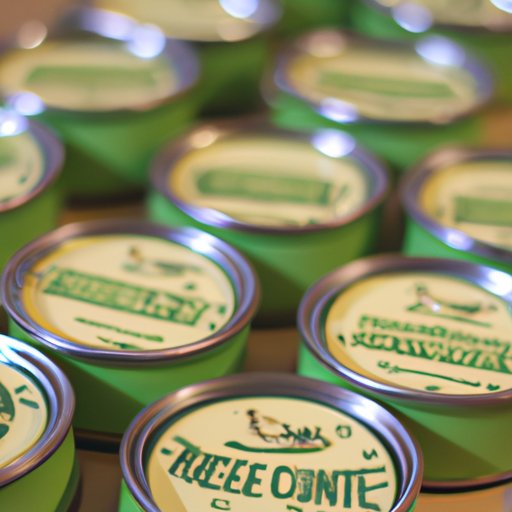
Introduction
Many people who participate in home canning are faced with the question of whether or not they can reuse canning lids. On one hand, reusing lids can save money and resources. On the other hand, reusing lids can also pose health risks and compromise the quality of the food. In this article, we’ll explore the pros and cons of reusing canning lids, debunk common myths and misconceptions, provide tips on how to safely reuse lids, and more.
The Pros and Cons of Reusing Canning Lids: A Comprehensive Guide
Before we dive deeper into the subject, let’s take a look at the main advantages and disadvantages of reusing canning lids.
Advantages of Reusing Canning Lids
One of the most obvious benefits of reusing canning lids is saving money. Canning lids can be expensive, and being able to reuse them can be a significant advantage for those who frequently participate in home canning. Additionally, reusing canning lids can help reduce waste by prolonging the lifespan of the lids.
Disadvantages of Reusing Canning Lids
However, there are also some significant disadvantages to reusing canning lids. First and foremost, reusing lids can compromise the seal on the jar, which can lead to spoilage or even food poisoning. Additionally, reusing lids can cause the quality of the food to deteriorate over time, as repeated use can cause the lids to become less effective at protecting the food from air and other elements.
Can You Really Reuse Canning Lids? Debunking Myths and Facts
There are many myths and misconceptions surrounding the reuse of canning lids. In this section, we’ll sort fact from fiction and provide you with the truth about canning lid reuse.
Common Misconceptions and Myths About Reusing Canning Lids
One of the most common misconceptions about reusing canning lids is that you can simply boil them to sterilize them for reuse. However, this is not the case. Boiling canning lids can damage the seal and compromise their effectiveness, leading to potential health risks. Additionally, some people believe that reusing the lids from store-bought canned goods is acceptable, but this is also not recommended as these lids may not be designed for reuse.
The Truth About Canning Lid Reuse
The truth is that while it is technically possible to reuse canning lids, it is not recommended for safety reasons. The seal on the lid is designed to be used once, and reusing it can result in a compromised seal, which can allow bacteria and other harmful elements to enter the jar. If you must reuse canning lids, it is important to do so safely and cautiously.
Sustainable Canning: The Benefits and Risks of Reusing Canning Lids
Sustainability is an important consideration for many canners. In this section, we’ll explore the benefits and risks associated with the reuse of canning lids in the context of sustainability.
Importance of Sustainability in Canning
Canning is a popular method of food preservation, but it can also be a resource-intensive process. By reusing canning lids, canners can prolong the lifespan of the lids and reduce waste, which can have a positive impact on the environment.
Risks Associated with Reusing Canning Lids
However, the risks associated with reusing canning lids cannot be ignored. As we mentioned earlier, reusing canning lids can result in compromised seals, which can lead to spoilage or even food poisoning. This can have serious health consequences and negate any positive impact the reuse of the lid may have had on the environment.
How to Know When Canning Lids Can Be Reused Safely
If you must reuse canning lids, there are steps you can take to minimize the risks associated with their reuse. In this section, we’ll provide some tips for ensuring the safe reuse of canning lids.
Factors to Consider When Reusing Canning Lids
There are several factors to consider when deciding whether or not to reuse canning lids. These include the condition of the lid, the type of food being canned, and the storage conditions of the canned food. Additionally, it is important to only reuse lids that are free of visible damage or warping.
Tips for Ensuring Safe Reuse of Canning Lids
If you have decided to reuse canning lids, there are some steps you can take to ensure their safe use. First, make sure the lids are clean and free of any debris or residue. Next, inspect them carefully for any signs of damage or wear. Finally, do not reuse lids that have been in storage for an extended period of time or that have been exposed to extreme temperatures.
Upcycling Canning Lids: DIY Projects and Creative Ideas
If you have a collection of canning lids that you cannot reuse, don’t throw them away! There are many fun and creative ways to use canning lids beyond canning. In this section, we’ll explore some DIY projects and creative ideas for upcycling canning lids.
Fun and Creative Ways to Use Canning Lids Beyond Canning
Some fun and creative ways to use canning lids include using them as coasters, making them into Christmas ornaments, using them as bases for mini planters, and more. The possibilities are endless!
DIY Projects Using Canning Lids
There are also many DIY projects that use canning lids, such as making a light fixture, creating a wreath, or making a wind chime. These projects can be a fun and rewarding way to repurpose old canning lids.

The Environmental Footprint of Canning Lids: Why Reusing Matters
The impact of canning lids on the environment cannot be ignored. In this section, we’ll explore the environmental impact of canning lids and why reusing matters.
Environmental Impact of Canning Lids
The production, transportation, and disposal of canning lids can have a significant environmental impact. By reusing canning lids, we can reduce the amount of waste that is generated and minimize the resources required to produce new lids.
Benefits of Reusing Canning Lids for the Environment
Additionally, reusing canning lids can have a positive impact on the environment by reducing the demand for new lids. By prolonging the lifespan of canning lids, we can help conserve resources and reduce the environmental impact of canning.
Canning Lid Alternatives: Exploring Other Options for Your Canning Needs
If you are concerned about the risks associated with reusing canning lids, there are alternatives available. In this section, we’ll explore some of the options available for your canning needs.
Alternatives to Canning Lids
There are several alternatives to canning lids, including reusable silicone lids, glass jars with clamp lids, and Tattler reusable canning lids. These alternatives can eliminate the need for single-use canning lids and reduce waste.
Comparison of Different Options
Each alternative to canning lids has its own set of advantages and disadvantages, so it is important to consider your individual needs and preferences when selecting an option.
Conclusion
In conclusion, while reusing canning lids can be a cost-effective and sustainable option, it is important to do so safely and cautiously. The risks associated with reusing canning lids should not be ignored, and canners should take steps to ensure the safe reuse of lids if they choose to do so. Additionally, there are many fun and creative ways to upcycle canning lids, and by reusing them we can reduce waste and minimize the environmental impact of canning.
Final Thoughts and Recommendations
If you frequently participate in home canning, it may be worth considering alternatives to single-use canning lids. Reusable options, such as silicone lids or glass jars with clamp lids, can be a cost-effective and sustainable way to can your food without compromising safety or quality. If you do choose to reuse canning lids, make sure to take the necessary precautions to ensure their safe use.




